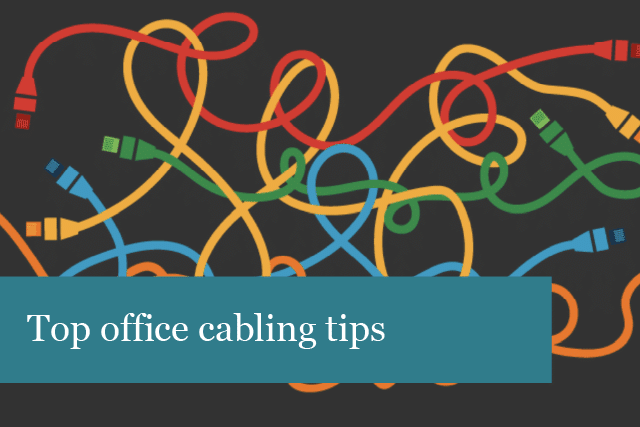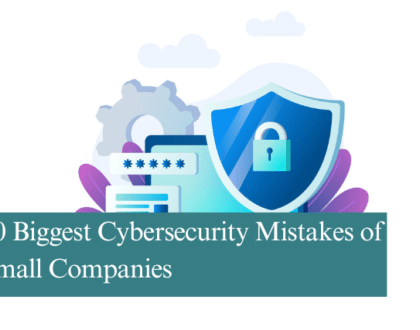
When it comes to your company network, one of the last things you may think about is the cabling. Yet consider this: cables are an integral part of your network. Without the cables, there would be no network. What would happen if a couple of your network’s main cables failed?
This is why it’s important to consider the cabling of the company’s network. Cables need to be correctly maintained in order ensure your business network doesn’t fail, causing a major disruption and extended downtime.
We’ve put together some tips to help ensure your network’s cabling is installed, maintained and properly managed to keep the network up and running.
1). Create a Plan Before Trouble Hits
Was a layout created before installation of your network? If not, you could have a problem develop if not now, then in the future. The reason is that the layout of the network may be inefficient, and cables may be run incorrectly, which could also be dangerous.
Cables that dangle from the ceiling not only look bad, but they could even pose a fire hazard. And if cables are strung across the floor, employees or visitors could easily trip and fall, leading to serious injuries and possible law suits.
Instead, take time to consider the layout of network cables, working to ensure they’re run properly. Also make sure cables are not placed where they can become overheated.
If you’re moving to a new office, then be sure to plan a layout that will give the most efficient use of the system and ensure cables are properly located and installed.
2). Use Labels
An office network can be convoluted and include a wide range of hardware, connected devices and more. All of this includes cables, which can make it difficult to sort later if there’s a problem. To keep it all straight, consider labelling all network cables.
Unlabelled cables only cause more confusion, especially when an issue’s developed with the network. Think of all the time and effort wasted trying to find a problem cable, when you have sort through a spaghetti network of cables that all look the same.
Labelling cables makes it much easier to find and fix problems. It’s best to place a label at each end of every cable that is installed, even for those short-run cables. The next time something goes wrong, you’ll be able to find the problem and fix it sooner. This means your business won’t be offline for extended periods why everyone hunts for the right cable.
Another way that labels help is when it’s time to move office. If every cable is labeled, getting the office network and devices reconnected won’t take as long. It will be obvious which cables go where when it’s time to reconnect everything at the new office space.
3). Use Colour Coding
Along with labels, colour coding of cables can also help. This method involves using specific colours for cables that have different roles on the network.
Not only does this make running the cable easier, when a problem some come up, it’s easy to find which cables and their connections. You’ll find it easier and faster to find and fix problem cables.
4). Use Correct Cable Lengths
This may seem obvious, but sometimes it’s easy to forget that cables should be the correct length. For instance, cables that are snarled or snaking around offices make maintenance more challenging. In addition, they can also make it harder to find a problem and get it fixed.
Not only that, but not paying attention to proper cable lengths also can be a waste of money. Consider that cable is charged by the foot. If you end up using too much cable, cost of cables will increase dramatically, especially if you have a large company with numerous departments.
5). Avoid Sharp Bends & Twists
The highest quality cable will not be a benefit to your system if it’s not handled correctly. For instance, if cable is twisted or bent sharply, it can lead to poor transmission and speed loss. A twisted cable can also break easily.
6). Abide by Cabling Standards
Just as there are standards for electrical wiring, there are also cabling installation standards. These standards ensure cables are installed efficiently and safely. You’ll have a network that is more effective, too, by following the cabling standards.
7). Keep Data and Electric Cables Separated
Network cables should not run alongside electric cables. The reason is that data cables generate a magnetic field, which is essential for efficient transmission. Data cables are not protected against the magnetic field created by electricity, so the network cables will not be able to function effectively if placed too close to electric cables.
8). Watch for Interference
Magnetic fields of other types can also interfere with data cables. Magnetic fields generated by fluorescent lamps, motors and more can interfere with network cables. For this reason, data cables should be placed carefully to avoid this type of interference.
9). Document Cable Layouts
Creating a document of the cable layouts for each part of the business is another essential step. This includes creating a diagram of where cables are located, the floor layout for each office/area, and the identification of each cable, cable type, and more.
This record should be kept in the IT department and referred to when making changes to office layouts, cable runs, or when problems arise in the network.
10). Use Cable Protectors
Where cables cross areas where people walk, consider the use of cable protectors. These should have a non-slip surface and underside, making them safe to step on, without damaging the cables. The protectors should also correctly fit the thickness of your cables, and they’ll make easier to access cables without having to pull them all up to fix a problem.
While cable management may not be at the top of your to-do list, it is a crucial process for your business. Not only does proper cable management keep your business running efficiently. It will be easier to find and fix problems and prevent accidents. Not only that, but your office will also have a more professional appearance.
Recommended Posts

10 Biggest Cybersecurity Mistakes of Small Companies
18th April 2025

The Importance of Planning in Business IT Solutions
11th April 2025

